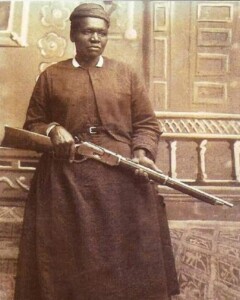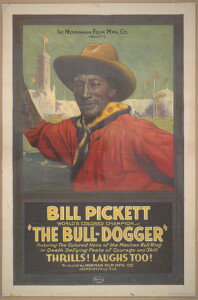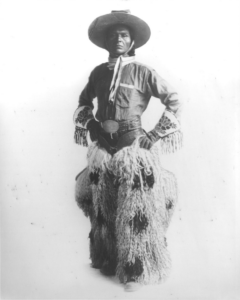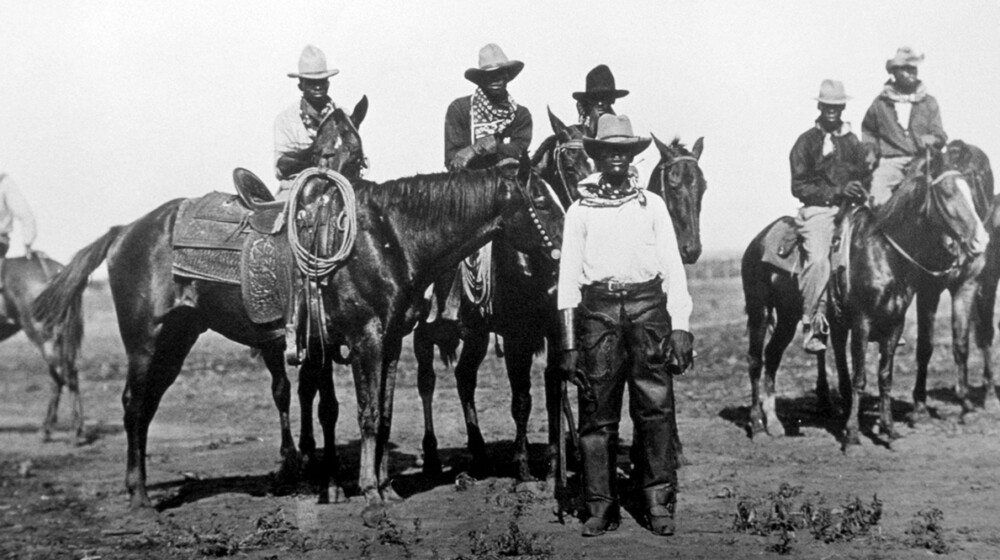The Wildly Diverse West
Did You Know…
 When we think of cowboys, we think of ranches, rodeos, lassos, buckaroos, corrals, broncos, lariats, chaps, and mustangs.
When we think of cowboys, we think of ranches, rodeos, lassos, buckaroos, corrals, broncos, lariats, chaps, and mustangs.
These words evoke a detailed picture of cowboys and the American West. Each of them are also derived from Spanish words and cattle herding traditions that came to what is now the United States from Mexico as early as the 1500s. That’s right – the original American cowboy was a vaquero that looked more like Anthony Quinn (who was usually cast as the ethnic “bad guy” in 20th century Westerns) than the stereotypical image of Gary Cooper or John Wayne.
-
Cowboy Terminology
- bronco (bronco) – untamed horse of the American Southwest (c1850)
- chaparejos (chaps) – leather overalls worn to protect riders’ legs (c1844)
- corral (corral) – pen or enclosure for horses or cattle (c1840)
- rancho (ranch) – country house or small farm (c1808); large stock-farm and herding establishment (c1831)
- la reata (lariat) – the rope; to tie against (c1832)
- lazo (lasso) – snare or slipknot (c1807)
- rodeo (rodeo) – cattle round up (c1834)
- mestengo (mustang) – animal that strays (c1808)
- vaquero (buckaroo) – cowboy (c1827)
-
Women in the West

Mary Fields, undated photo.
Women have also been portrayed unrealistically in Hollywood depictions of the American West, shown generally in their relation to the men in the story being told – as wives, prostitutes and madams, and/or victims of violence instead of people/characters in their own right. There were definitely women who fit into those categories (and some in more than one), but also many who did not. One such woman was Mary Fields, otherwise known as Stagecoach Mary.
Mary Fields was born in Tennessee and enslaved from her birth. After the Civil War, Mary moved to Ohio and then Montana, where she worked at a mission, set up a laundry, did odd jobs, and tried to get into the restaurant business – reportedly only failing because she would give free food to people who couldn’t afford to pay. In 1895, Mary Fields was independently contracted by US Post Office Department to be a Star Route Carrier, driving a stagecoach to deliver mail in the wilds and weather of Northern Montana. When the snow was too deep to drive the stagecoach, Mary (who was in her 60s!) would complete her 34-mile route on foot, with snowshoes.
Learn more about Mary Fields from the National Parks Service and the Smithsonian National Postal Museum.
Learn more about Women and the Myth of the American West from Zócalo Public Square (an Arizona State University Knowledge Enterprise).
 Latinos aren’t the only ones left out of the mythological picture of the American cowboy – Native Americans and African Americans worked cattle, too, sometimes as enslaved or forced labor, and sometimes as paid labor. Black cowhand Bose Ikard was with Charles Goodnight and Oliver Loving when they charted the Goodnight-Loving Cattle Trail in 1866. Goodnight said this about Ikard, “There was a dignity, a cleanliness, and a reliability about him that was wonderful…(He was) the most skilled and trustworthy man I had.” African American cowboy Bill Pickett was known in Oklahoma as, “the greatest sweat and dirt cowhand that ever lived – bar none.” But he is remembered in history as the inventor of bulldogging (also known as steer wrestling) – the only one of eight rodeo sports that is credited to an individual. Jackson Sundown (Waaya-Tonah-Toesits-Kahn) of the Nez Perce tribe was a long-time popular horseman at rodeos around the turn of the century, winning the World Title in the 1916 Pendleton Round-Up Saddle Bronc Championship at the age of 53. When he would ride the crowd would whistle, stomp and cheer, “Ride ’em, Sundown!” He has been inducted into the American Indian Athletic Hall of Fame, the National Multicultural Western Heritage Museum and Hall of Fame, the National Cowboy and Western Museum and Hall of Fame, the Pendleton Roundup Hall of Fame, and the Idaho Hall of Fame. He died in 1923 of pneumonia, one year before Congress “granted” US citizenship to Native Americans.
Latinos aren’t the only ones left out of the mythological picture of the American cowboy – Native Americans and African Americans worked cattle, too, sometimes as enslaved or forced labor, and sometimes as paid labor. Black cowhand Bose Ikard was with Charles Goodnight and Oliver Loving when they charted the Goodnight-Loving Cattle Trail in 1866. Goodnight said this about Ikard, “There was a dignity, a cleanliness, and a reliability about him that was wonderful…(He was) the most skilled and trustworthy man I had.” African American cowboy Bill Pickett was known in Oklahoma as, “the greatest sweat and dirt cowhand that ever lived – bar none.” But he is remembered in history as the inventor of bulldogging (also known as steer wrestling) – the only one of eight rodeo sports that is credited to an individual. Jackson Sundown (Waaya-Tonah-Toesits-Kahn) of the Nez Perce tribe was a long-time popular horseman at rodeos around the turn of the century, winning the World Title in the 1916 Pendleton Round-Up Saddle Bronc Championship at the age of 53. When he would ride the crowd would whistle, stomp and cheer, “Ride ’em, Sundown!” He has been inducted into the American Indian Athletic Hall of Fame, the National Multicultural Western Heritage Museum and Hall of Fame, the National Cowboy and Western Museum and Hall of Fame, the Pendleton Roundup Hall of Fame, and the Idaho Hall of Fame. He died in 1923 of pneumonia, one year before Congress “granted” US citizenship to Native Americans.
 Latinos, Native Americans, and African Americans consisted of about a third of all cowboys during the “golden age” of the American cowboy (between 1866 and 1895). There is a plethora of information out there about their forgotten and overlooked stories – here is a partial list of those we found and used to research this article (please let us know if you know of any others and we’ll add them here!):
Latinos, Native Americans, and African Americans consisted of about a third of all cowboys during the “golden age” of the American cowboy (between 1866 and 1895). There is a plethora of information out there about their forgotten and overlooked stories – here is a partial list of those we found and used to research this article (please let us know if you know of any others and we’ll add them here!):
Books
- The Black West, by William Loren Katz
- Black Cowboys of the West, by Tricia Martineau Wagner
Articles
- Black Cowboys Were Common in the Old West, AZ Central
- How Hollywood Whitewashed the Old West, The Atlantic
- Native American Cowboys, The Team Roping Journal
- Ranching Traditions (Santa Cruz Valley, AZ), Archaeology Southwest
- The Last Cowboy, PBS Independent Lens
- The Lesser Known History of African American Cowboys, Smithsonian Magazine
- The Making of the Cowboy Myth, The Saturday Evening Post
- The Other Slavery (book review), The Santa Fe New Mexican
- Vaqueros, Library of Congress
- Why it’s Time to Retire the Whitewashed Western, BESE
Learn more about the history of ranching in Arizona from our April 2023 blog article, C is for Cattle.
The top photograph is of African American cowboys in Texas, c1913 (Getty Images); the second is a lithograph of Mexican rancheros, c1834 (California State Library); the third is a 1923 Bill Pickett movie poster (Smithsonian); and the fourth is of Jackson Sundown at the Pendleton Roundup (Oregon Historical Society). The historical cowboy terminology comes from the Online Etymology Dictionary.
Archive
-
2025
-
January (1)
-
-
2024
-
December (1)
-
November (1)
-
October (1)
-
September (1)
-
August (1)
-
July (1)
-
June (1)
-
May (1)
-
April (1)
-
March (1)
-
February (1)
-
January (1)
-
-
2023
-
December (1)
-
November (1)
-
October (1)
-
September (1)
-
August (1)
-
July (1)
-
June (1)
-
May (1)
-
April (1)
-
March (1)
-
February (1)
-
January (1)
-
-
2022
-
December (1)
-
November (1)
-
October (1)
-
September (1)
-
August (1)
-
July (1)
-
June (1)
-
May (1)
-
April (1)
-
-
2021
-
December (1)
-
November (1)
-
October (1)
-
September (1)
-
August (1)
-
July (1)
-
June (1)
-
May (1)
-
April (1)
-
March (1)
-
February (1)
-
January (1)
-
-
2020
-
December (1)
-
November (1)
-
October (1)
-
September (1)
-
August (1)
-
July (1)
-
June (1)
-
May (1)
-
April (1)
-
March (1)
-
February (1)
-
January (1)
-
-
2019
-
December (1)
-
November (1)
-
October (1)
-
September (1)
-
August (1)
-
July (1)
-
June (1)
-
May (1)
-
April (1)
-
March (1)
-
February (1)
-
January (1)
-
-
2018
-
December (1)
-
November (1)
-
October (1)
-
September (1)
-
August (1)
-
July (1)
-
May (1)
-
April (1)
-
March (1)
-
February (1)
-
January (1)
-
-
2017
-
December (1)
-
November (1)
-
October (1)
-
September (1)
-
August (1)
-
July (1)
-
June (1)
-
May (1)
-
April (1)
-
March (1)
-
February (1)
-
-
2016
-
December (1)
-
-
2015
-
2014
-
July (1)
-
